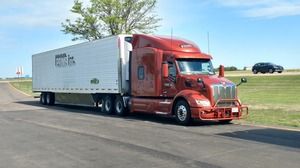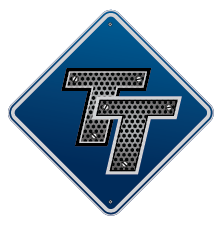Flatbedder Schedules
Topic 1505 | Page 1

I rarely have a scheduled pick up/delivery time. Mostly, it's show up in the morning and get unloaded. If I do, it almost always has something to do with steel of some sort, and it's not a big deal. Also some job sites have scheduled times to offload roofing insulation or Firestone rubber roofing rolls with a crane right up to the roof.

I have just recently changed from pulling a reefer to flatbed for Prime. I have found for the most part (at least for Prime) that most pickup/delivery is during the day during the week. Vary rarely do we deliver/pickup on weekends/evenings.
So to answer your question, it seems that flatbed is more like a regular schedule than reefer/dry van. You do have the occasional drop/hook, but mostly live load/unload.
Hope this helps.
Ernie
Dry Van:
A trailer or truck that that requires no special attention, such as refrigeration, that hauls regular palletted, boxed, or floor-loaded freight. The most common type of trailer in trucking.Reefer:
A refrigerated trailer.

If you drive for a regional-type flatbed company, you get a lot of loads that you pick up one day, and deliver the next morning, because they don't go more than 300-500 miles. But you can get some longer runs also.
Regional:
Regional Route
Usually refers to a driver hauling freight within one particular region of the country. You might be in the "Southeast Regional Division" or "Midwest Regional". Regional route drivers often get home on the weekends which is one of the main appeals for this type of route.
Thanks Ernie and Ken, very helpful.
Have a good weekend guys :)
Zen Joker, I'm a flat-bedder and a lot of the times my delivery times will tell me what day of the week and what hours they will be receiving. As an example it may tell me to deliver on June the 9th from 7am - 3pm. Therefore you get to manage your own time and make it work out however you want to manage your own clock. Some people will prefer driving all night and arriving at 7am, get unloaded and then go take a break. Another person may prefer to drive all day on the day ahead and get to the receiver that night and shut down waiting for them to arrive in the morning and unload when they get started that morning, then go get another load and drive all day again. You'll figure all this out once you get your own chance to do it. What you don't want to make a habit of is getting there at the last minute - I see a lot of drivers doing this. This is the kind of stuff that keeps you from being able to get on another load that same day. These are the little details that help you be successful at this.
Most of my loads are live loads, but occasionally we have customers that we leave empty flat-bed trailers at so we can just go drop and hook when they let us know that we have a loaded trailer ready.
There are also a few industrial sites that I go to that only load or only receive between the hours of midnight and six a.m.
One of the great things about driving a truck is the independent way the job is managed. Once you get the hang of how to manage your time you really can be creative and make it work to your advantage. I recently ran a high value load with about 2800 miles on the trip. Since this load is worth about 1.4 million dollars, for security reasons they want us to run it with another driver who is carrying the same load. We had to stop at the same places together, park together, and stay together the whole trip. We would discuss driving over meals together and I discovered real quickly that he didn't get near the miles that I do, and it was simply a matter of not understanding some simple techniques about managing the hours. After several conversations I thought I could see the light bulb going off in his mind, and he thanked me profusely for sharing with him things that no one else had ever explained to him. For me it just seems like common sense, but when a person hasn't been exposed to the ins and outs of the rules of HOS they don't realize what they can be doing to help themselves out and still stay within the legal limits of the law. I give my props to Brett's High Road Training Program because that section on logs in there has mad my career far more successful than it would have been had I not been exposed to the nuances of the law and how the rules work.
CDL:
Commercial Driver's License (CDL)
A CDL is required to drive any of the following vehicles:
- Any combination of vehicles with a gross combined weight rating (GCWR) of 26,001 or more pounds, providing the gross vehicle weight rating (GVWR) of the vehicle being towed is in excess of 10,000 pounds.
- Any single vehicle with a GVWR of 26,001 or more pounds, or any such vehicle towing another not in excess of 10,000 pounds.
- Any vehicle, regardless of size, designed to transport 16 or more persons, including the driver.
- Any vehicle required by federal regulations to be placarded while transporting hazardous materials.
Drop And Hook:
Drop and hook means the driver will drop one trailer and hook to another one.
In order to speed up the pickup and delivery process a driver may be instructed to drop their empty trailer and hook to one that is already loaded, or drop their loaded trailer and hook to one that is already empty. That way the driver will not have to wait for a trailer to be loaded or unloaded.
HOS:
Hours Of Service
HOS refers to the logbook hours of service regulations.Zen Joker, I'm a flat-bedder and a lot of the times my delivery times will tell me what day of the week and what hours they will be receiving. As an example it may tell me to deliver on June the 9th from 7am - 3pm. Therefore you get to manage your own time and make it work out however you want to manage your own clock. Some people will prefer driving all night and arriving at 7am, get unloaded and then go take a break. Another person may prefer to drive all day on the day ahead and get to the receiver that night and shut down waiting for them to arrive in the morning and unload when they get started that morning, then go get another load and drive all day again. You'll figure all this out once you get your own chance to do it. What you don't want to make a habit of is getting there at the last minute - I see a lot of drivers doing this. This is the kind of stuff that keeps you from being able to get on another load that same day. These are the little details that help you be successful at this.
Most of my loads are live loads, but occasionally we have customers that we leave empty flat-bed trailers at so we can just go drop and hook when they let us know that we have a loaded trailer ready.
There are also a few industrial sites that I go to that only load or only receive between the hours of midnight and six a.m.
One of the great things about driving a truck is the independent way the job is managed. Once you get the hang of how to manage your time you really can be creative and make it work to your advantage. I recently ran a high value load with about 2800 miles on the trip. Since this load is worth about 1.4 million dollars, for security reasons they want us to run it with another driver who is carrying the same load. We had to stop at the same places together, park together, and stay together the whole trip. We would discuss driving over meals together and I discovered real quickly that he didn't get near the miles that I do, and it was simply a matter of not understanding some simple techniques about managing the hours. After several conversations I thought I could see the light bulb going off in his mind, and he thanked me profusely for sharing with him things that no one else had ever explained to him. For me it just seems like common sense, but when a person hasn't been exposed to the ins and outs of the rules of HOS they don't realize what they can be doing to help themselves out and still stay within the legal limits of the law. I give my props to Brett's High Road Training Program because that section on logs in there has mad my career far more successful than it would have been had I not been exposed to the nuances of the law and how the rules work.
Much appreciated old wise one. Appreciate the insight
CDL:
Commercial Driver's License (CDL)
A CDL is required to drive any of the following vehicles:
- Any combination of vehicles with a gross combined weight rating (GCWR) of 26,001 or more pounds, providing the gross vehicle weight rating (GVWR) of the vehicle being towed is in excess of 10,000 pounds.
- Any single vehicle with a GVWR of 26,001 or more pounds, or any such vehicle towing another not in excess of 10,000 pounds.
- Any vehicle, regardless of size, designed to transport 16 or more persons, including the driver.
- Any vehicle required by federal regulations to be placarded while transporting hazardous materials.
Drop And Hook:
Drop and hook means the driver will drop one trailer and hook to another one.
In order to speed up the pickup and delivery process a driver may be instructed to drop their empty trailer and hook to one that is already loaded, or drop their loaded trailer and hook to one that is already empty. That way the driver will not have to wait for a trailer to be loaded or unloaded.
HOS:
Hours Of Service
HOS refers to the logbook hours of service regulations.New Reply:
New! Check out our help videos for a better understanding of our forum features

















Preview:








 TT On Facebook
TT On Facebook
First off, I understand that a trucker's schedule is inconsistent and always changing. Since many flatbed loads are moved with Cranes, etc. is it a fair statement to say that a flatbedder's may have a slightly more consistent schedule than van drivers since there is no drop and hook? Or do they have just as many odd hours appointments/deadlines and drive sometimes as many odd hours (midnight to 6 am) as van drivers?
Appreciate any insight.
Drop And Hook:
Drop and hook means the driver will drop one trailer and hook to another one.
In order to speed up the pickup and delivery process a driver may be instructed to drop their empty trailer and hook to one that is already loaded, or drop their loaded trailer and hook to one that is already empty. That way the driver will not have to wait for a trailer to be loaded or unloaded.